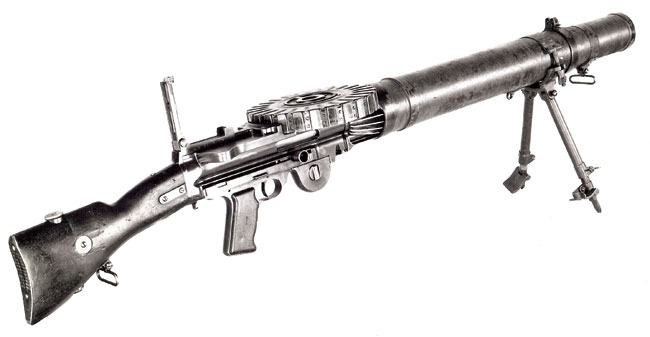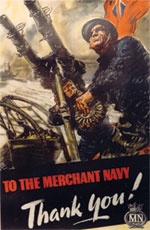The first use of the Lewis gun in combat was by Belgian forces as they had bought some just prior to the outbreak of the war and would have used them against the invading German army. The distinctive sound the gun made during firing, due to the barrel jacket extending beyond the muzzle, combined with the delaying combat tactics of the Belgians, earned it the nickname “Belgian Rattlesnake” by the Germans.
As manufacturing increased both in England and the United States, the British Army greatly increased the number of guns put into action. A British battalion had sixteen platoons in four companies and by 1918 each platoon had two Lewis guns with another four at Battalion Headquarters for anti-aircraft defense.
By the end of the war, large scale production ended. Though the gun had many excellent features and characteristics (portable, one man operation, ease of changing pan magazines, resistant to environmental fouling, etc.) it was a complex gun susceptible to a bewildering number of stoppages. There was much room for improvement in the light machine gun category and was ultimately replaced by the Bren gun as standard British issue in 1935. A British Small Arms Training manual dated 1931, Volume II, lists six “immediate action” stoppages and seven possible stoppages for the Lewis gun. The detailing and explanation of the stoppages added up to thirty one pages of small print. Considered obsolete, the Lewis was relegated to a secondary armament role but fortunately a large inventory was on hand. After the debacle at Dunkirk, the Lewis gun once again stepped in to fill the desperate need of the British army to arm trawlers, motor torpedo boats, ground anti-aircraft positions and the Home Guard.

The Lewis was officially adopted by Great Britain and widely used by Belgium, France and the United States for ground, air and naval use. The Yokosuka Naval Arsenal in Yokosuka, Japan manufactured copies of the Lewis gun for the Japanese Navy in 1929. Norway also manufactured the Lewis just prior to World War II.
There were a number of accessories for the Lewis gun that included: fold down front anti-aircraft ring sight, rear anti-aircraft sight to mount on top of leaf sight, front and rear illuminated night sights carried in a metal box, pan magazine lever loading tool, post style pan loading tool, metal ammunition chest that carries six pan magazines, canvas pan magazine carrier that holds four magazines, leather gunner’s kit than contains a spare bolt, cocking knob, extractor, firing pin, spring, mouthpiece spanner, gas chamber spanner, clearing plug (ruptured case extractor), combination scale for spring tensions measurement with screw driver one end and “bullet point” on the other end for turning the gas key regulator.
The Lewis gun is considered one of the classic machine guns of World War I and is recognized as the first practical light machine gun produced in large quantities used in a large armed conflict. Its distinctive profile, portability and general ease of operation ranks it as the true forerunner of later light machine guns.
Operation
The primary principle on which the gun worked was gas operation. A small hole was drilled into the barrel. As the bullet traveled past the hole the rapidly expanding gasses behind it would be tapped off from the barrel through the hole into a gas accumulation chamber where it would impinge upon a piston driving it rearward. The piston was connected to an operating rod and bolt. During this rearward movement the bolt would extract the spent cartridge case and eject it through the ejection port to the right rear. A stud located on top of the bolt also engaged a feed arm which engaged and extracted the next round from the double layer, circular pan magazine located on the top of the gun. The mechanism had two stop pawls that ensured that the magazine rotated the correct distance to line up the next cartridge. Additionally, during the rearward movement of the piston, operating rod and bolt, a rack on the underside of the operating rod engaged a pinion which wound a clock-type spring, located just in front of the trigger that would store the energy needed to return the operating parts forward while chambering and firing the next round. The bolt had rotating locking lugs that locked into recesses in the barrel extension and unlocked when high pressure was reduced to a safe level.

The cooling mechanism was unique to the Lewis gun and its actual cooling capabilities versus the added weight have been a source of debate for years. The entire barrel is enclosed in a deeply flanged aluminum radiator casing. The aluminum radiator casing was then enclosed by an outer steel jacket open at both the front and rear to allow air to circulate along the entire length of the finned aluminum casing. Col. Lewis’ theory was that since the steel outer casing projects beyond the end of the muzzle of the barrel, the muzzle blast would cause the air to be sucked in from the rear opening passing along the length of the aluminum radiator casing thus assisting in cooling. This forced draught cooling system has since been proven to be over-rated and the gun works quite well without it. The aircraft Lewis gun did away with the aluminum radiator casing and the outer steel casing altogether with no ill effect to operational use.
Specifications
Weight of gun: 26 pounds without bi-pod
Length of gun: 50.5”
Length of barrel: 26.25”
Caliber: .303 British
Number of grooves: 4
Twist: Left
Cooling: Forced air
Sights: Front – Blade, Rear – Leaf to 1,900 yards
Muzzle velocity: 2,440 feet per second
Range: Effective – 800 yards, Maximum – 3,500 yards
Feed: Double layer circular pan of 47 rounds
Cyclic rate of fire: 550 rounds per minute
Type of fire: Full automatic only
“Lewis Gunners”
They dwell in a medley of pawls and springs,
Of pinions, and lugs, and racks,
Of cylinders, vents, and various things
Which the average rifle lacks.
My word! How they polish, and oil, and clean,
Ad Nauseam every day,
But you’ll always find them alert and keen –
For that is the gunner’s way.
At night-time they dream the most terrible dreams
Of feed-arms and left-handed screws;
Their slumber with grooved-tailed monstrosities teems
Till they’re nigh in a fit of the blues.
Those number two stoppages haunt them by night,
And also far into the day;
Their remarks would, I’m sure, set asbestos alight –
That is also the gunner’s way.
Up on the fire-step they’ll often be found
Peering earnestly over the top,
Taking mental impressions of all that’s around,
Watching planes, and where Fritz’s shells drop.
On the qui vive for gas, ready for the alarm
At all hours of night or of day;
Alert and intelligent, watchful and calm,
As is always the gunner’s way.
They pound Fritz in gaps which are torn in his wire,
When his gangs are out working at night;
They rake all his trenches with enfilade fire
Till he’s thankful to keep out of sight.
They draw all his fire till the bombers get near,
And pepper him from the next bay,
Then it’s “Kamerade, mercy!” and off to the rear –
That’s the Allemand gunner’s way.
There’s a deadly “Five-nine” that’s a fav’rite of Fritz,
There are glistening Taubes overhead;
There’s a gun and its gunners now shattered to bits,
There are several more names ‘mong the dead.
But their duty is done, as was e’er their proud boast,
For the peace of their souls let us pray:
God rest them, brave lads! For they died at their post –
That is ever the gunner’s way.







